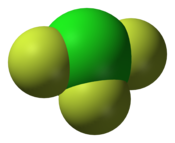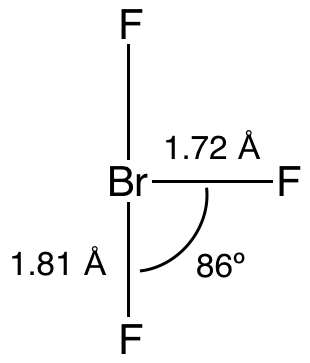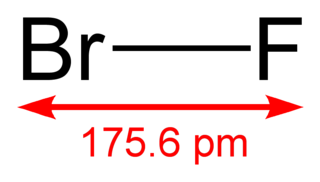Types of interhalogens
| F | |||||
|---|---|---|---|---|---|
| Cl | |||||
| Br | Br2 | ||||
| I | IBr, IBr3 | ||||
| At | unknown | AtBr | At2(?) | ||
| F | Cl | Br | I | At |
Diatomic interhalogens

The interhalogens of form XY have physical properties intermediate between those of the two parent halogens. The covalent bond between the two atoms has some ionic character, the less electronegative halogen, X, being oxidised and having a partial positive charge. All combinations of fluorine, chlorine, bromine, and iodine that have the above-mentioned general formula are known, but not all are stable. Some combinations of astatine with other halogens are not even known, and those that are known are highly unstable.
- Chlorine monofluoride (ClF) is the lightest interhalogen compound. ClF is a colorless gas with a normal boiling point of −100 °C.
- Bromine monofluoride (BrF) has not been obtained as a pure compound — it dissociates into the trifluoride and free bromine. It is created according to the following equation:
- Br2(l) + F2(g) → 2 BrF(g)
Bromine monofluoride dissociates like this:
- 3 BrF → Br2 + BrF3



- Iodine monofluoride (IF) is unstable and decomposes at 0 °C, disproportionating into elemental iodine and iodine pentafluoride.
- Bromine monochloride (BrCl) is a yellow-brown gas with a boiling point of 5 °C.
- Iodine monochloride (ICl) exists as red transparent crystals that melt at 27.2 °C to form a choking brownish liquid (similar in appearance and weight to bromine). It reacts with HCl to form the strong acid HICl2. The crystal structure of iodine monochloride consists of puckered zig-zag chains, with strong interactions between the chains.
- Astatine monochloride (AtCl) is made either by the direct combination of gas-phase astatine with chlorine or by the sequential addition of astatine and dichromate ion to an acidic chloride solution.
- Iodine monobromide (IBr) is made by the direct combination of the elements to form a dark red crystalline solid. It melts at 42 °C and boils at 116 °C to form a partially dissociated vapour.
- Astatine monobromide (AtBr) is made by the direct combination of astatine with either bromine vapour or an aqueous solution of iodine monobromide.
- Astatine monoiodide (AtI) is made by direct combination of astatine and iodine.
No astatine fluorides have been discovered yet. Their absence has been speculatively attributed to the extreme reactivity of such compounds, including the reaction of an initially formed fluoride with the walls of the glass container to form a non-volatile product. [lower-alpha 1] Thus, although the synthesis of an astatine fluoride is thought to be possible, it may require a liquid halogen fluoride solvent, as has already been used for the characterization of radon fluorides. [10] [11]
In addition, there exist analogous molecules involving pseudohalogens, such as the cyanogen halides.
Tetratomic interhalogens

- Chlorine trifluoride (ClF3) is a colourless gas that condenses to a green liquid, and freezes to a white solid. It is made by reacting chlorine with an excess of fluorine at 250 °C in a nickel tube. It reacts more violently than fluorine, often explosively. The molecule is planar and T-shaped. It is used in the manufacture of uranium hexafluoride.
- Bromine trifluoride (BrF3) is a yellow-green liquid that conducts electricity — it self-ionises to form [BrF2]+ and [BrF4]−. It reacts with many metals and metal oxides to form similar ionised entities; with other metals, it forms the metal fluoride plus free bromine and oxygen; and with water, it forms hydrofluoric acid and hydrobromic acid. It is used in organic chemistry as a fluorinating agent. It has the same molecular shape as chlorine trifluoride.
- Iodine trifluoride (IF3) is a yellow solid that decomposes above −28 °C. It can be synthesised from the elements, but care must be taken to avoid the formation of IF5. F2 attacks I2 to yield IF3 at −45 °C in CCl3F. Alternatively, at low temperatures, the fluorination reaction
- I2 + 3 XeF2 → 2 IF3 + 3 Xe
- can be used. Not much is known about iodine trifluoride as it is so unstable.
- Iodine trichloride (ICl3) forms lemon yellow crystals that melt under pressure to a brown liquid. It can be made from the elements at low temperature, or from iodine pentoxide and hydrogen chloride. It reacts with many metal chlorides to form tetrachloroiodides (ICl−
4), and hydrolyses in water. The molecule is a planar dimer (ICl3)2, with each iodine atom surrounded by four chlorine atoms. - Iodine tribromide (IBr3) is a dark brown liquid.
Hexatomic interhalogens

All stable hexatomic and octatomic interhalogens involve a heavier halogen combined with five or seven fluorine atoms. Unlike the other halogens, fluorine atoms have high electronegativity and small size which is able to stabilize them.
- Chlorine pentafluoride (ClF5) is a colourless gas, made by reacting chlorine trifluoride with fluorine at high temperatures and high pressures. It reacts violently with water and most metals and nonmetals.
- Bromine pentafluoride (BrF5) is a colourless fuming liquid, made by reacting bromine trifluoride with fluorine at 200 °C. It is physically stable, but decomposes violently on contact with water, organic substances, and most metals and nonmetals.
- Iodine pentafluoride (IF5) is a colourless liquid, made by reacting iodine pentoxide with fluorine, or iodine with silver(II) fluoride. It is highly reactive, even slowly with glass. It reacts with water to form hydrofluoric acid and with fluorine gas to form iodine heptafluoride. The molecule has the form of a tetragonal pyramid.
Octatomic interhalogens

- Iodine heptafluoride (IF7) is a colourless gas and a strong fluorinating agent. It is made by reacting iodine pentafluoride with fluorine gas. The molecule is a pentagonal bipyramid. This compound is the only known interhalogen compound where the larger atom is carrying seven of the smaller atoms.
- All attempts to synthesize bromine or chlorine heptafluoride have met with failure; instead, bromine pentafluoride or chlorine pentafluoride is produced, along with fluorine gas.












